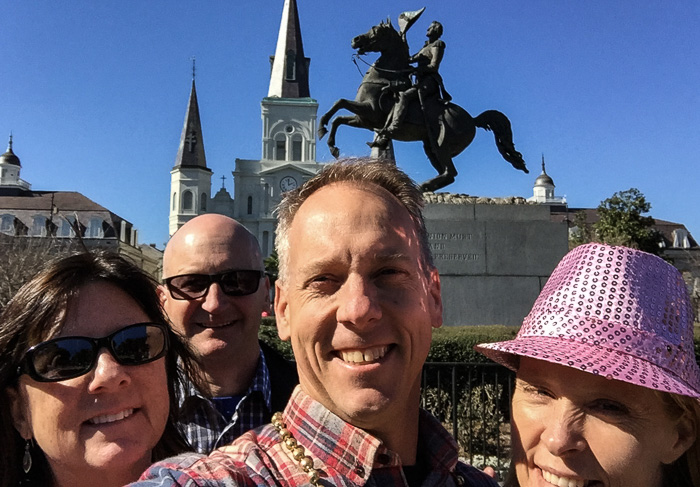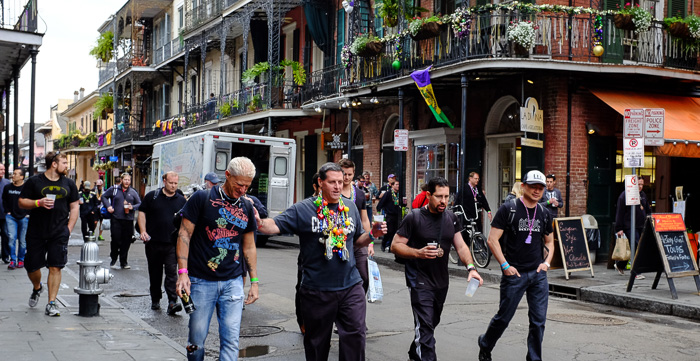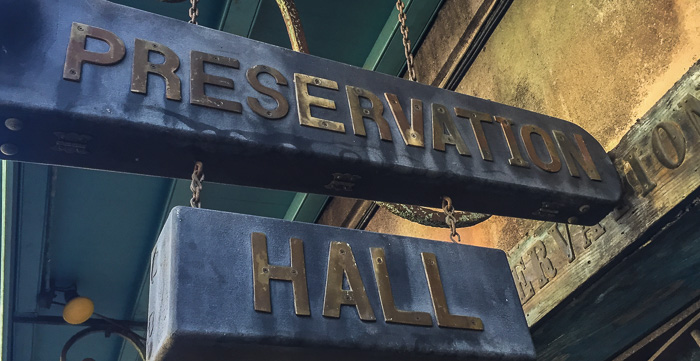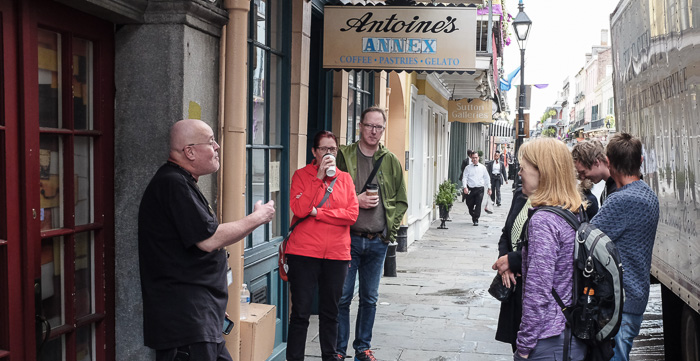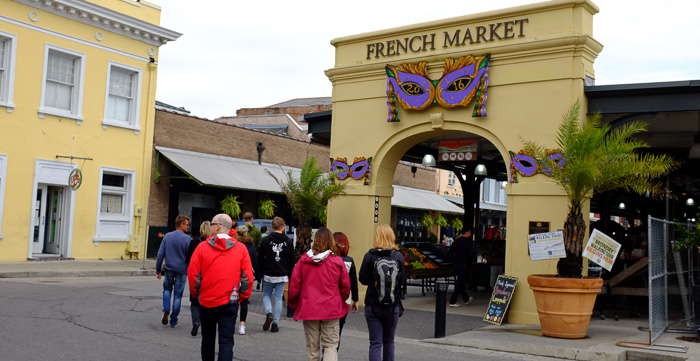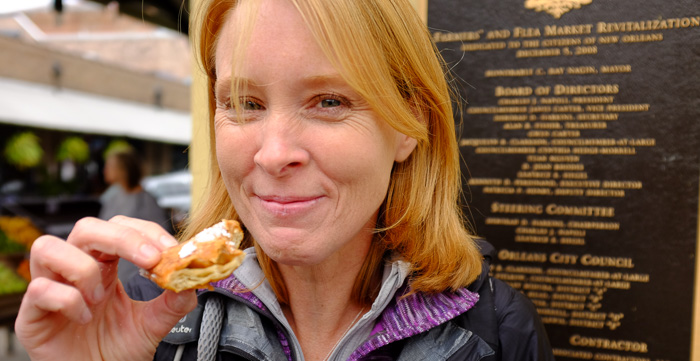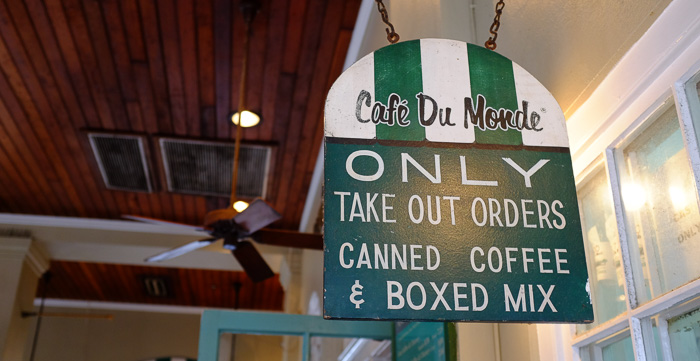New Orleans: The French Quarter, Preservation Hall, our Culinary History Tour, and FOOD FOOD FOOD
We spent five days in New Orleans and our action-packed itinerary took us to the French Quarter three times: first an evening walk followed by dinner and jazz at Preservation Hall, next a mid-morning culinary walking tour, and lastly a brief afternoon stroll to soak in the ambiance and purchase praline before catching our flight home. You’d think that was enough, but the French Quarter will be tops on my list for a return visit to take in the atmosphere and:
- See more sights: We strolled Bourbon Street, Jackson Square and the French Market, but I’d still like to see St. Louis Cathedral and pop into more shops like the Jamie Hayes Gallery. I’d also hit iconic bars like Lafitte’s Blacksmith Shop Bar (the oldest bar in the U.S.), the Sazerac Bar in the The Roosevelt, and the Napolean House to name a few. We were fortunate to see the unique Carousel Bar in Hotel Monteleone, and listen to dueling pianos (while sampling a Hurricane!) in Pat O’Brien’s.
- Visit museums: Of the many available, two caught my eye: The Presbytere, with halls devoted to Mardi Gras and Hurricane Katrina, and the lesser known (and free) Historic New Orleans Collection, with Louisiana history galleries and changing exhibits.
- Listen to music: We never got around to Frenchman Street for the outstanding music scene; recommended clubs include The Spotted Cat and Snug Harbor. I also had my eye on Irvin Mayfield’s Jazz Playhouse in the Royal Sonesta.
I realize I’m straying from the French Quarter, but while I’m documenting my “next time” list, many also suggest strolling the popular Magazine Street for galleries, shops and restaurants.
Please don’t think I’m complaining! We had ZERO sightseeing regrets and considered ourselves very lucky to see so many parades and spend time with Anne’s wonderful family. In fact, we hit the jackpot. How many people get to sample Gay’s cooking (shrimp and crawfish étouffée, stuffed mirlitons, jambalaya…YUM!!) or get to hang out at Miss Ethel’s and play London Rummy??
One final aside: New Orleans was under Spanish rule for about 40 years in the late 1700s and the most significant influence still seen today is in French Quarter architecture. One tour guide pointed out that when the Spanish came, settlers were still building with wood which burned often. The Spanish insisted on rebuilding with non-flammable brick, creating a French Quarter that is reminiscent of an old Spanish town. This article expands on the myriad competing French and Spanish influences in the French Quarter.
And now, two of our fabulous experiences in the French Quarter, Preservation Hall and the Culinary History Walking Tour:
Preservation Hall
According to their website, Preservation Hall hails back to 1961 when it was established to “honor one of America’s truest art forms - Traditional New Orleans jazz”. As the story goes, traditional jazz was struggling to retain its audience with the rise of rock and roll and bebop in the 1950s. Around that time, Larry Borenstein opened an art gallery in New Orleans and found himself too busy to get out and listen to his beloved but dwindling jazz scene. To solve his music crisis, Larry invited local musicians to rehearse in his gallery. Jam sessions grew in size, started to attract living legends, and became so popular Larry moved his gallery to the building next door. Regular performances took hold and Preservation Hall was born when Larry passed day-to-day music operations over to Allan Jaffe, an ardent fan of New Orleans jazz.
Preservation Hall is still considered to be the place to find traditional New Orleans jazz and I loved experiencing a classic jazz set in such an intimate setting. It was a extra-special treat to have Shannon Powell “The King of Treme” sit in (!), and to hear outstanding solos from Mark Braud on trumpet in Sugar Blues and David Harris on trombone in Mood Indigo. Robin Barnes “The Songbird of New Orleans” treated us to It’s a Wonderful World, and the band played a killer rendition of Little Liza Jane.
It was a superlative jazz experience but the environment leaves many dissatisfied. Expect the space to be crowded and warm. No food or beverages are sold inside, but you’re free to bring a drink in. Seating is very limited so unless you pay the big bucks for a reserved spot, plan to stand for 60 minutes to hear a 45-minute set; we got lucky and were first in line for the 10pm show which ensured we’d get seats. The only negative for us: we sat on the right (as you are facing the stage) and during quiet numbers, we could hear music from Pat O’Brien’s next door. It was distracting, but probably only heard by those sitting directly against that wall.
Website: preservationhall.com
Location: 726 St Peter St, New Orleans, LA 70116
Hours: 45-minute shows at 8pm, 9pm, and 10pm nightly.
Cost: $15-$20 for walk-up; $35-$50 for “Big Shot” reserved seating. The joint is very popular so if visiting New Orleans during peak times, purchase tickets online in advance, or arrive an hour early to stand in line for the cheap tickets.
New Orleans Culinary History Tour
I loved this tour from Free Tours by Foot! Our guide, David Westbrook, was warm, funny, knowledgeable, and engaging. I can’t imagine a better introduction to New Orleans and I highly recommend this tour at the start of a visit. David gave a concise history of the city, how its early settlers influenced the cuisine, and shared interesting asides about New Orleans culture. I was impressed before we met given the detailed confirmation email I received the night before, but David went above and beyond by sending a follow-up email listing the many restaurants he’d recommended during the tour.
David was hard to resist, starting and ending the tour with a heartfelt thank you, and insisting that we were now locals and not “tourist-es”. He also had us laughing out loud with colorful descriptions like: sucking the meat out of a crawfish is a “silky smooth spicy slurp of cajun ecstasy” and blackened foods are not burned but rather a “sexy spicy hunk of seasoned meat”.
I think David’s love for the city (and its food!) set him apart. He likened giving tours of New Orleans to introducing his fiancé to his family - she may be rough around the edges and have a checkered past, but he loves her and wants his family to love her too.
David made it clear that to understand New Orleans, you have to understand its settlers. Here’s a super-brief and hopefully accurate early history. Note that David didn’t go into this much detail; this is an amalgamation of information from our various tour guides:
- In 1682, the French explorer LaSalle claimed all lands drained by the Mississippi for France, and named the territory Louisiana in honor of King Louis XIV.
- In 1700, d’Iberville (one of the French de Moyne brothers) sailed the Mississippi and founded the first permanent French settlement in Louisiana. Though d’Iberville left the area soon after never to return, his colony was vital to the success of the territory and he is considered Louisiana’s founder.
- In 1718, de Bienville (another de Moyne brother), founded La Nouvelle-Orleans on a bend in the Mississippi River. Bienville was governor of Louisiana for four terms and is the Father of New Orleans.
- In 1762 after Britain’s victory in the Seven Years War, France ceded Louisiana to Spain.
- In 1800, Spain signed a treaty giving Louisiana back to France but in April 1803 Napolean sold it to the United States as part of the Louisiana Purchase.
So New Orleans was founded and settled by the French, then ruled by Spain for over 40 years. It’s also important to note the arrival of “les Acadians” (aka Cajuns) in the early 1700s who were French colonists from the Acadia region of Canada, forcibly relocated by the British. Cajuns settled multiple areas including the coastal marshes of New Orleans.
David explained that the terms “Creole” and “Cajun” refer to both a people and a type of cuisine. The Cajun are straightforward, defined as the displaced Acadians living in rural Louisiana. They’re country folk. Creole is more difficult to nail down but generally “French Creole” describes descendants of Spanish and French colonists and “Louisiana Creole” describes someone of mixed racial ancestry including native born-slaves and free people of color. Whoever their ancestors, Creole are generally city folk.
This country vs. city split is the easiest way to remember the difference between Cajun and Creole food. At its simplest, if a dish has tomatoes, it is Creole. Going deeper, the Creole had access to a wider array of ingredients and more time to prepare foods leading to exotic seafood dishes and complex creamy sauces like remoulade.
Cajuns by contrast, had to make do with little. As David recounted, they wanted their food to taste as good as Creole so they compensated with spices. You can also spot Cajun food by the meat used since “When a Cajun goes out to hunt, they look for something that fights back” - think alligator, venison, pork, duck, or lamb. Both Creole and Cajun dishes often start with “the holy trinity” of onion, celery and bell pepper and add “the Pope” (garlic) for good measure.
David gave in-depth descriptions and histories of jambalaya, gumbo, muffaletta, po-boy, beignet and praline (pronounced praw-lean in these parts) making us seriously hungry by the end. He also offered a few pieces of advice:
- Graze: There are scads of excellent restaurants and many are known for one signature dish. Hop around sampling specialties, like a hot muffaletta at Napolean House followed by Bananas Foster from Brennan’s (they invented it).
- Take advantage of lunch specials: Top restaurants are seriously expensive at dinner-time. Experience the same food at lunch for a portion of the cost. Antoine’s apparently offers a prix fixe lunch for about $25 and sweetens the pot with a 25-cent martini special, although they cut you off at 75 cents!
- Buy sauces and spices at the grocery store: Shops often sell spice mixes and hot sauces like Slap Ya Mama at a serious mark-up. Go to a Rouse’s grocery store to find the same stuff for a lot less.
I’ll give a few more of David’s restaurant recommendations (just as he emailed them) but to get more, take his tour and hear it first-hand! These are but seven of over one hundred restaurants he listed:
- Muffaletta: Central Grocery, 923 Decatur Street $
- Po-Boy: Parkway Bakery, 538 Hagan Ave. (Mid City) $$
- Beignet: Cafe Du Monde, 800 Decatur Street, French Quarter (24 Hrs)/ The Outlet Collection at Riverwalk, 1 Poydras Street, #500 (open until 9pm) $
- Breakfast: Camellia Grill, 626 S. Carrollton Ave. (on St. Charles Ave. Streetcar Line @ Riverbend) / 540 Chartres Street, French Quarter $
- Creole (haute cuisine with Dress Code): Commander’s Palace, 1403 Washington Avenue, Garden District $$$$
- Cajun: K-Paul’s Louisiana Kitchen, 416 Chartres Street, French Quarter $$$
- Seafood & Oysters: Acme Oyster House, 724 Iberville Street, French Quarter $$
Final piece of advice (from me, not David): save the dieting for before or after your New Orleans trip, not during!
Website: freetoursbyfoot.com
Location: Tour meets at Antoine’s Restaurant, 713 St Louis St, New Orleans, LA 70130
Hours: Tour at 10am daily
Cost: Pay what you feel the tour is worth. Other walking tours of this type cost $20-$25 per person.
Mileage/Duration: About 1 mile of walking over 2.5 hours
This post is part of a Trip Summary: New Orleans Mardi Gras
